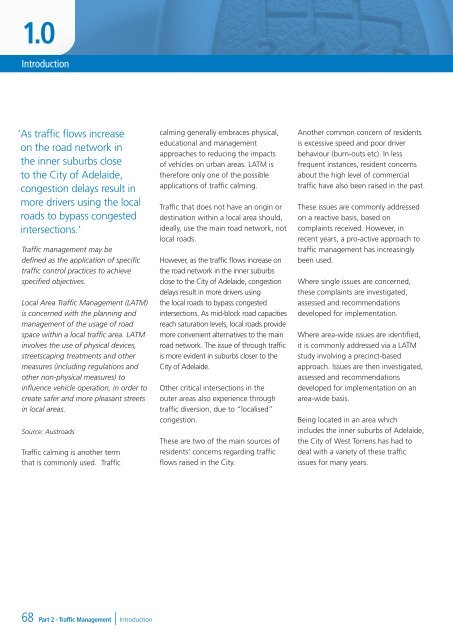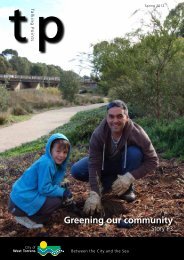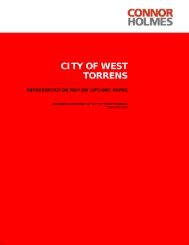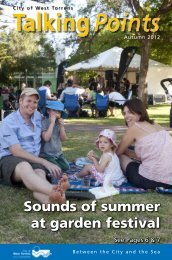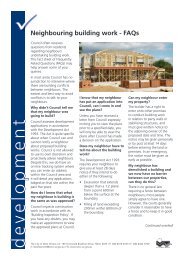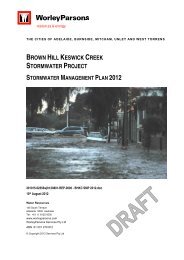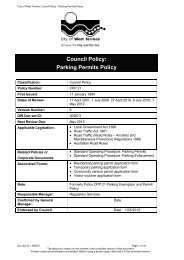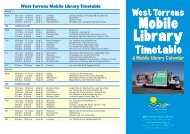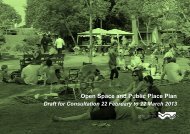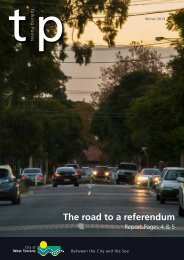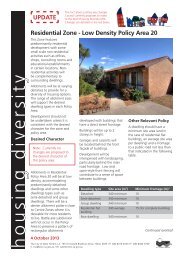Recommendations - City of West Torrens - SA.Gov.au
Recommendations - City of West Torrens - SA.Gov.au
Recommendations - City of West Torrens - SA.Gov.au
Create successful ePaper yourself
Turn your PDF publications into a flip-book with our unique Google optimized e-Paper software.
1.0<br />
Introduction<br />
‘ As traffic flows increase<br />
on the road network in<br />
the inner suburbs close<br />
to the <strong>City</strong> <strong>of</strong> Adelaide,<br />
congestion delays result in<br />
more drivers using the local<br />
roads to bypass congested<br />
intersections.’<br />
Traffic management may be<br />
defined as the application <strong>of</strong> specific<br />
traffic control practices to achieve<br />
specified objectives.<br />
Local Area Traffic Management (LATM)<br />
is concerned with the planning and<br />
management <strong>of</strong> the usage <strong>of</strong> road<br />
space within a local traffic area. LATM<br />
involves the use <strong>of</strong> physical devices,<br />
streetscaping treatments and other<br />
measures (including regulations and<br />
other non-physical measures) to<br />
influence vehicle operation, in order to<br />
create safer and more pleasant streets<br />
in local areas.<br />
Source: Austroads<br />
Traffic calming is another term<br />
that is commonly used. Traffic<br />
calming generally embraces physical,<br />
educational and management<br />
approaches to reducing the impacts<br />
<strong>of</strong> vehicles on urban areas. LATM is<br />
therefore only one <strong>of</strong> the possible<br />
applications <strong>of</strong> traffic calming.<br />
Traffic that does not have an origin or<br />
destination within a local area should,<br />
ideally, use the main road network, not<br />
local roads.<br />
However, as the traffic flows increase on<br />
the road network in the inner suburbs<br />
close to the <strong>City</strong> <strong>of</strong> Adelaide, congestion<br />
delays result in more drivers using<br />
the local roads to bypass congested<br />
intersections. As mid-block road capacities<br />
reach saturation levels, local roads provide<br />
more convenient alternatives to the main<br />
road network. The issue <strong>of</strong> through traffic<br />
is more evident in suburbs closer to the<br />
<strong>City</strong> <strong>of</strong> Adelaide.<br />
Other critical intersections in the<br />
outer areas also experience through<br />
traffic diversion, due to “localised”<br />
congestion.<br />
These are two <strong>of</strong> the main sources <strong>of</strong><br />
residents’ concerns regarding traffic<br />
flows raised in the <strong>City</strong>.<br />
Another common concern <strong>of</strong> residents<br />
is excessive speed and poor driver<br />
behaviour (burn-outs etc). In less<br />
frequent instances, resident concerns<br />
about the high level <strong>of</strong> commercial<br />
traffic have also been raised in the past.<br />
These issues are commonly addressed<br />
on a reactive basis, based on<br />
complaints received. However, in<br />
recent years, a pro-active approach to<br />
traffic management has increasingly<br />
been used.<br />
Where single issues are concerned,<br />
these complaints are investigated,<br />
assessed and recommendations<br />
developed for implementation.<br />
Where area-wide issues are identified,<br />
it is commonly addressed via a LATM<br />
study involving a precinct-based<br />
approach. Issues are then investigated,<br />
assessed and recommendations<br />
developed for implementation on an<br />
area-wide basis.<br />
Being located in an area which<br />
includes the inner suburbs <strong>of</strong> Adelaide,<br />
the <strong>City</strong> <strong>of</strong> <strong>West</strong> <strong>Torrens</strong> has had to<br />
deal with a variety <strong>of</strong> these traffic<br />
issues for many years.<br />
68<br />
Part 2 - Traffic Management | Introduction


